Victor Block's Scotland
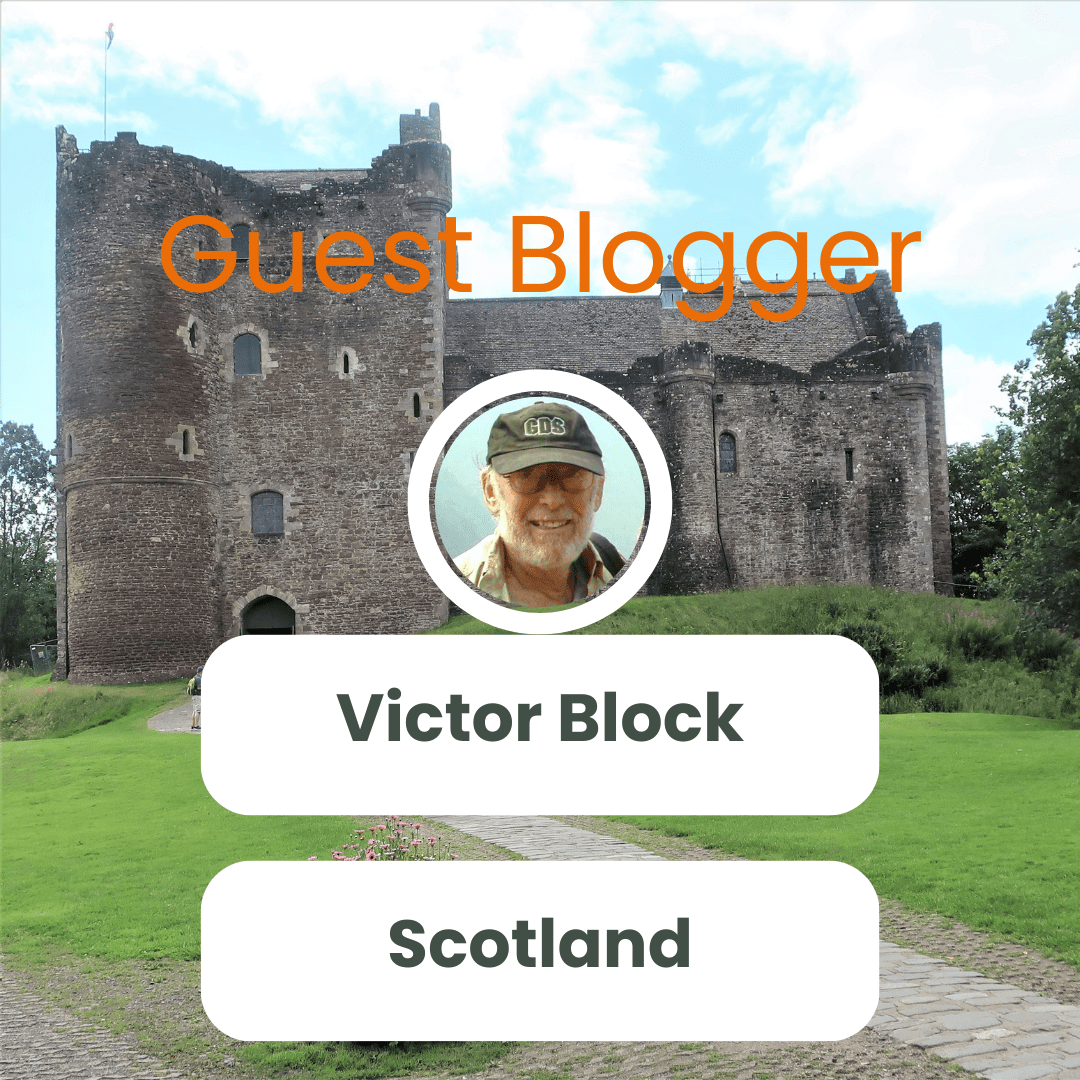
In 1093, the monarch of Scotland directed a group of men to race up a steep hill in his search for a fast runner to serve as the royal messenger. From that kingly contest, they evolved into what is known today as the Highland Games.
During a recent visit to Scotland, my introduction to the Games underscored some of the attractions and appeals the country offers visitors.
I watched in awe and admiration as burly men dressed in colorful tartan kilts competed in throwing logs called cabers, tossing heavy metal balls attached to a wooden pole, and participating in other athletic events, some familiar and others unlike any I've seen.
Marching bands playing bagpipes and, yes, wearing kilts thrilled the onlookers. Nearby stood stately castles, some of which were built well before Columbus set sail for the New World, and charming towns, each with unique stories to relate.
About our Guest Blogger:
Victor Block
Victor Block has been a travel journalist for many years, and has traveled throughout the United States and to nearly 80 other countries.
He has written for major newspapers, magazines and travel websites and served as an editor of Fodor’s Travel Guides.
He is a member of the Society of American Travel Writers and the North American Travel Journalists Association. Victor’s stories have won numerous awards from both writers’ organizations and other countries.
Victor believes that travel can add to everyone’s education and understanding, and that he still has a lot to learn. He loves to explore new destinations and cultures, and to share his experiences with his travel writer wife, Fyllis, and with readers.
THE HIGHLANDS AND CENTRAL SCOTLAND: TWO UNIQUE REGIONS
Both are replete with a fascinating history, serve as sources of Scotland's rich traditions, and provide visitors with an inviting list of things to see and do.
Both are home to craggy mountains, rolling farmlands dotted by grazing sheep, and the still waters of lochs (lakes). No wonder a recent poll conducted by Rough Travel Guides included Scotland among the "Most beautiful countries in the world."
One realization that continues to confront me is Scotland's antiquity. The past coexists with the present so naturally and seamlessly in only a few other places I've visited.
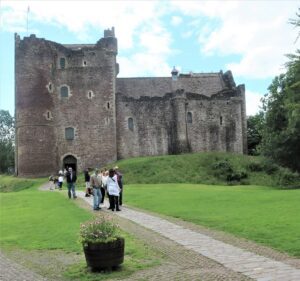 Castles that date their age in many centuries overlook deep valleys from their hillside perches. Stirling Castle is in a city of the same name known as the "Gateway to the Highlands." Actors in period attire brought the palace's history to life as they described its colorful past.
Castles that date their age in many centuries overlook deep valleys from their hillside perches. Stirling Castle is in a city of the same name known as the "Gateway to the Highlands." Actors in period attire brought the palace's history to life as they described its colorful past.
The oldest structures date back to the 14th century, and the Royal Palace looks much as it did when completed in the 16th century. Told to glance at the ceiling, I admired original wood-carved medallions that depict images of kings, queens, and other notables.
REMINDERS OF HISTORY ARE EVERYWHERE.
Doune (pronounced Dune) Castle dates to the 13th century. Its quintessential fortress-like façade appeared in Monty Python and the Holy Grail and, more recently, in the Outlander TV series.
The past also lives in cities and towns, including even the tiniest hamlets that make up in allure what they lack in size.
Inverness sits astride the Ness River, whose source is the loch where the famous fabled monster resides. This is a welcoming walking town with numerous inviting, cozy restaurants and small shops.
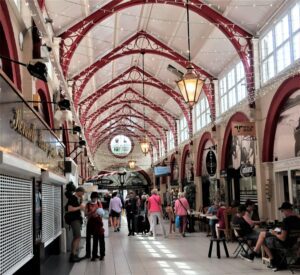
A personal favorite was the Victorian Market, which retains much of its original ornate splendor from 1891. Historic photographs line the walls, and independent purveyors – a butcher, fishmonger, watchmaker, and 30 others – add to the ambiance.
Dunblane (population about 9,000) stands on the banks of the Allan Water (River Allan), which previously powered factories and mills. Exhibits at the compact but outstanding Dunblane Museum trace the area's history. I found the collection of beggars' badges incredibly fascinating, which, in the 15th century, identified indigent people who had permission to plead for money.
The pleasant Darn Walk trail alongside the river links Dunblane with the Bridge of Allan, a 19th-century spa town that traces its history back to a hillside fortress built during the Iron Age.
Contrasting with towns that are small but significant in appeal is Edinburgh [pronounced Edin-borough], a magnificent city which, in many ways, is much more than just a pretty face. Its Old Town area earns its accolade as "the heart of Scotland's capital."
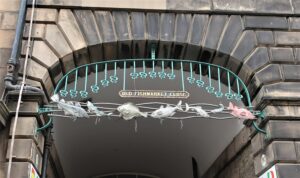 Stretching a mile through the city center, its stunning architecture is the backdrop to an active street life. Entertainers attract crowds of passers-by, and street musicians add a background of music to the setting.
Stretching a mile through the city center, its stunning architecture is the backdrop to an active street life. Entertainers attract crowds of passers-by, and street musicians add a background of music to the setting.
EDINBURGH
Edinburgh Castle overlooks the Royal Mile, as it's known, from a hilltop that has served as a defensive fortress since ancient Roman times. At the opposite end of the road is the Palace of Holyrood, the official residence of the English monarch in Scotland. King Charles III spent one week in residence each summer but was not there when we were, so that we couldn't drop by for tea.
Another favorite site for me was Real Mary King's Close, a narrow underground thoroughfare that provides a realistic immersion in the past. In the mid-17th century, Edinburg was confined primarily within its security walls, and housing was built in minor thoroughfares called closes, a Scottish word for alley.
These often were named for an occupant or the business or trade of residents, which accounts for signs identifying the Advocates, Bake House, and Old Fish Market close.
Real Mary King's Close is named after a merchant living there for a decade (1635-1645) and about 600 others. The tour delved into Mary's life, those of people from all social classes, and horror tales about Edinburgh's most deadly plaque.
THE TROSSACHS
Another site I suggest should be on a visitor's wish list is the Trossachs, an area of heavily wooded hills, yawning valleys, and rocky peaks. This landscape represents a microcosm of the Highlands' scenery in many ways.
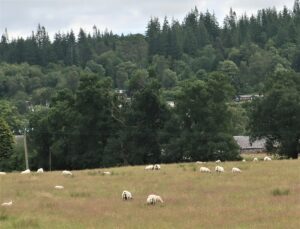 While my visit consisted of a self-driving tour and hike, other activities included animal and bird watching, fishing, and a boat ride on the loch. History lovers may check out prehistoric sites, including rock markings, burnt mounds, and artificial islands once occupied by lake dwellings.
While my visit consisted of a self-driving tour and hike, other activities included animal and bird watching, fishing, and a boat ride on the loch. History lovers may check out prehistoric sites, including rock markings, burnt mounds, and artificial islands once occupied by lake dwellings.
WHEN YOU GO…
I visited Scotland with Untours, whose "Live like the locals" motto describes its unique approach. Untours offers the advantages of independent travel, planning, on-site support like a tour, and other assistance.
Accommodation is never in hotels. I spent one week in a comfortable flat (apartment) in Inverness, in a building that had been a church dating to 1837, and another in a former woolen mill overlooking the small river that had powered it.
I received a wealth of helpful pre-trip information, the use of a rental car, and a first-day briefing and mini-tour at each location from the on-site Untours representative, who was available to provide help and information throughout our stay, along with other perks.
We could save money by cooking meals in the kitchen of our flat, which we enjoyed, or going to nearby restaurants. In Inverness, at Jimmy Badgers, we dined on mussels in garlic sauce served with crusty dipping bread and curried monkfish with two side dishes.
Darts and a jukebox help make the Village Inn in Dunblane popular with residents. It offers familiar fare like hamburgers and local favorites, including fish and chips (French fried potatoes).
Anyone planning to visit Scotland should be aware that the weather can, and often does, change quickly in a country about the size of South Carolina. Warm weather can turn chilly, and sunny weather can turn rainy without warning. One Scot with whom I spoke quipped, only half in jest, "It's either raining here or about to rain."
An even more significant challenge awaits those who, as I did, will be driving a car. That means a vehicle with the steering wheel on the right and doing your best to stay on the left side of the road. Untours provided a helpful primer about this in its pre-trip information, and I suggest a test drive around the rental agency lot before venturing out in traffic.
Even walking may be a task for some. Uneven stone pavements can turn a stroll into a minor ordeal.
For more information about Scotland, log onto visitscotland.com. To learn more about Untours, go to untours.com or call 888-868-6871.
(The Ageless Traveler gets no compensation from Untours. However, our writers may receive benefits from the companies they mention.)



